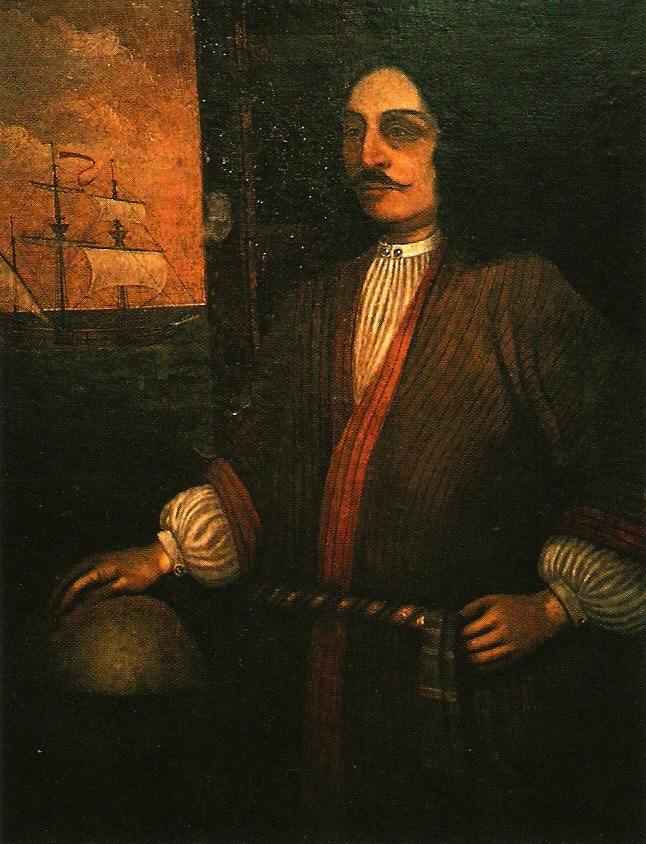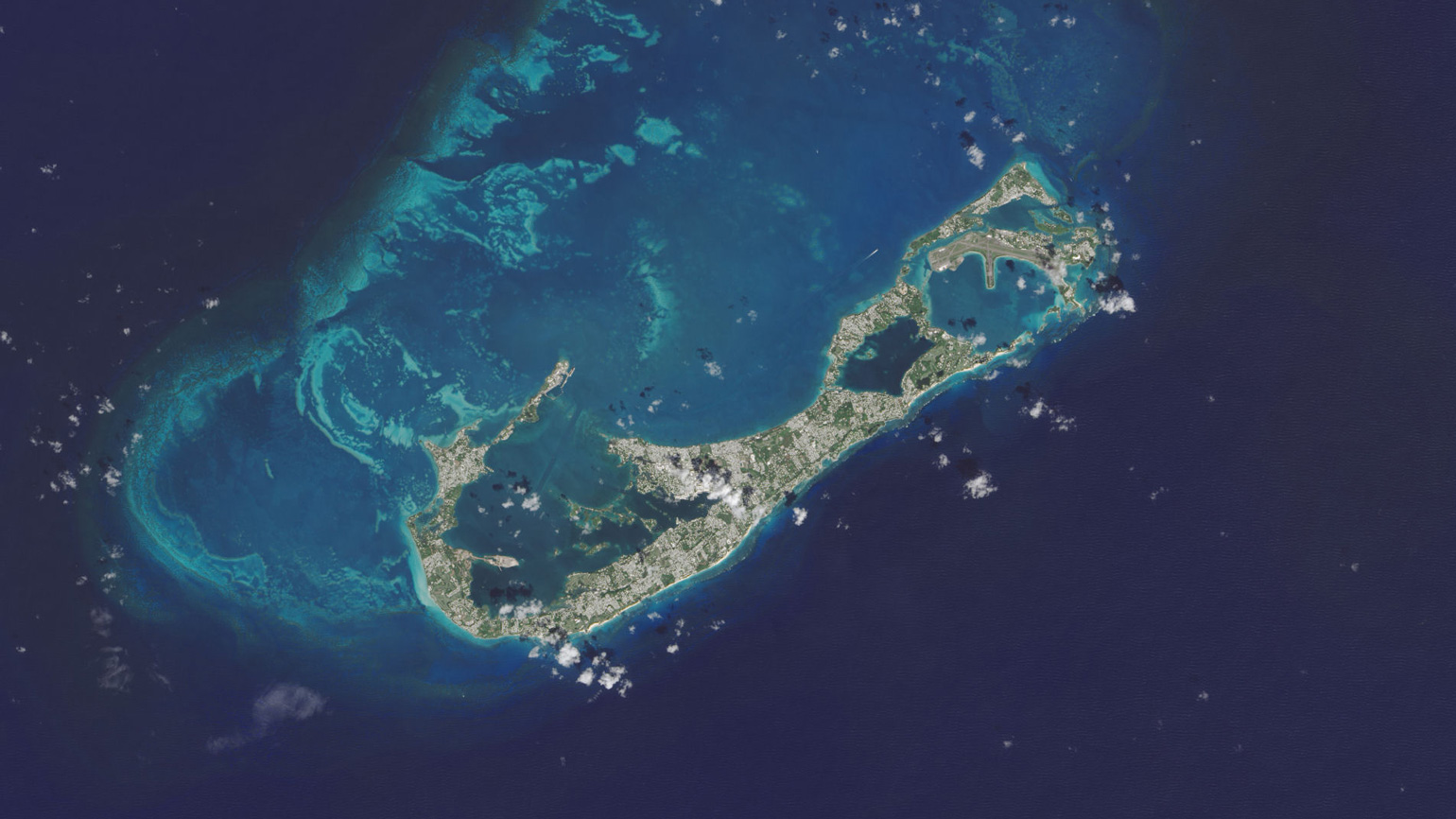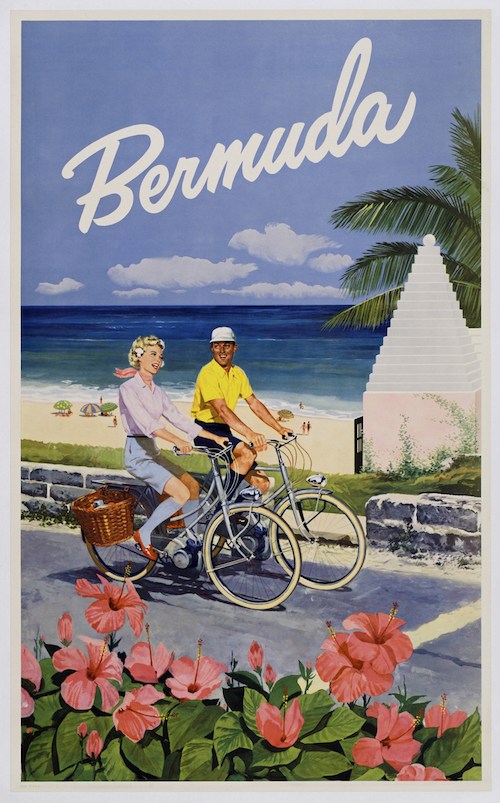
Although Bermuda remained uninhabited until the 1600s, it had been charted as early as 1511 in a book on Spanish exploration in the Caribbean by Peter Martyr. It is named for Juan de Bermudez who captained his ship La Garza near Bermuda in 1503. The name “Ya de demonios”, the Islands of Devils, is seen on a later map, the Mappa Mundi by Sebastian Cabot of 1544. Bermuda was so-named not only because her reefs were a hazard to navigate, but because strange sounds were often heard coming from the islands. Eventually those sounds were found to emanate from hogs and large sea birds.

Admiral Sir George Somers and his Sea Venture were part of a fleet of nine ships on its way to Jamestown
In the storm the fleet was scattered, one ship was never seen again. When Sir George shipwrecked on this land he focused on his original purpose. The settlers and crew soon built two new ships to continue on to Virginia and fulfill their duty. But Bermuda had found a way into their hearts. Hyperbolic description of the potential riches of the land, the pearls, ambergris, and the fertility of the land resulted in a Charter being sought by the same Virginia Company to invest and settle in Bermuda. Sir George died in Bermuda in 1610 when he returned to load up more food for the settlers in Virginia. He died from eating “a surfeit of pork”. We think this means food poisoning. According to local tradition, Sir George so loved Bermuda that he instructed his heart be buried here (his body was returned to his hometown in England, Lyme Regis). The exact location of the Bermuda burial site remains a subject of debate, although there is a plaque suggesting the vicinity of the burial in Somers Garden in St. George’s.
The first ship of settlers and the first Governor for Bermuda, Sir Richard Moore, arrived aboard the Plough in 1612. By 1614 they realized that Bermuda did not offer a great return on their investment and the Virginia Company surrendered Bermuda to the Crown. Bermuda then became a colony of Britain. Shortly after, a new company was formed called the Bermuda or Somers Isles Company. It was granted a Charter for “the plantation of the Somers Isles” by King James I, though Bermuda remained subject to His Majesty’s overall command. Bermuda was “rented” if you will, but tobacco did not thrive and the Bermuda Company was dissolved in 1684 with the colony reverting to the Crown.
Islanders did import and use slaves to create an economical pool of labour. The first official record of slaves in Bermuda was made in 1617, and the institution continued into the 1800s. Slavery was abolished in Bermuda in 1834.
After the Bermuda Company dissolved, the inhabitants were free of the restraints imposed by the conditions of the Charter and they became traders and privateers mostly between the Caribbean and North America. Many former slaves became skilled shipwrights and sailors of the Bermuda built ships. Later immigrants to the islands in any significant numbers were Portuguese who came to Bermuda as agricultural workers from the 1840s. In the late 1800s many immigrants from the West Indies also arrived.

Bermuda’s strategic position in the Atlantic has allowed it to play a special role in world events throughout its history. Bermuda remained officially loyal to the Crown during the American War of Independence, though gunpowder was unofficially provided to the revolutionaries in exchange for the lifting of a trade embargo. With the construction of the Royal Naval Dockyard in the early 1800s, Bermuda became Britain’s third Atlantic base (along with Halifax and Antigua) and was used successfully during the War of 1812. During the U.S. Civil War, Bermuda served as a trans-shipment centre for the Confederacy as they attempted to keep their cotton trade alive. Bermuda also played a strategic role in World War II when Britain signed a 99-year land lease with the United States providing them valuable lands for the establishment of military bases. The Americans built and maintained Bermuda’s airport (Kindley Field) until 2000 when they cut their lease short and returned all lands to Bermuda.

While Bermuda is still considered a prestige destination, tourism numbers have fallen since the heady days of the 1980s. Today’s dynamic and truly global travel industry is making new demands on the Bermuda product and its delivery. However, dedicated efforts to revamp and respond are ongoing.
Offsetting the downturn in tourism has been the rise of International Business. Bermuda plays a significant role in the global insurance market and is also known for fund and trust management and banking. A sensible regulatory environment, industry expertise, world-class telecommunications and a neutral tax environment are the keys to the growing success of this sector.
Bermuda's Timeline: 16th Century to the 21st Century |
||
| 16th Century | • | Bermuda is sighted by Spanish Seaman, Juan de Bermudez, before 1511 (when Bermuda was shown for the first time in Legatio Babylonica by Peter Martyr) |
| 1609 | • | Start of human settlement as a result of shipwreck of the Sea Venture which was bound for Virginia |
| 1612 | • | Permanent settlers arrive from England, one of them being Richard Moore, the first Governor, Town of St. George established |
| 1616 | • | One black and one Indian arrive from West Indies as indentured servants to dive for pearls |
| 1620 | • | House of Assembly formed, giving some measure of internal self-government. |
| • |
Economy: Whaling, shipbuilding, tobacco growing, and beginning of salt raking in Turks Island (1668 - 1801) |
|
| 1730 | • | Resistance to slavery continues to grow. First newspaper begins publication (Bermuda Gazette) |
| 1784 | • | First Postal Service begins |
| 1792 | • | Building of Hamilton Begins |
| • |
Economy: privateering becomes main economic activity as a result of hostilities between England and European countries |
|
| 1810 | • | Construction of Dockyard begins |
| 1815 | • | Hamilton becomes capital city |
| 1834 | • | Abolition of slavery |
| 1847 | • | Arrival of first Portuguese labourers |
| 1858 | • | First bank established |
| 1887 | • | Introduction of first telephone and cable service |
| 1894 | • | King Edward VII Memorial Hospital established |
| • |
Economy: Agriculture gains in economic importance; export of spring vegetables to eastern United States |
|
| 1901 | • |
Tourism emerges as winter season economic activity |
| 1904 | • |
Introduction of electricity |
| 1930 | • | Bermuda begins promoting itself as a summer tourist resort |
| 1931 | • | Bermuda Railway in operation (to 1948) |
| 1938 | • | Introduction of passenger air service between between Bermuda and New York |
| 1944 | • | Women's suffrage granted (with property qualification) |
| 1946 | • | General use of cars; establishment of first broadcasting station |
| 1963 | • | Establishment of first political party. |
| 1965 | • | Formation of Bermuda Regiment |
| 1968 | • | New Constitution brings Ministerial Government and first general election under universal adult suffrage |
| 1972 | • | Bermuda College is established |
| 1979 | • | Constitutional Conference; Women voluntarily join the Bermuda Regiment |
| 1984 | • | The Human Rights Act of 1981 becomes operative |
| 1997 | • | Pamela Gordon is appointed Premier by her United Bermuda Party colleagues, becoming the the first female to hold this position. |
| 1998 | • | The Progressive Labour Party wins its first general election, marking the first change in Government since the establishment of party politics thirty years ago |
| • | Jennifer M. Smith became the first female political party leader to become the Premier of Bermuda as a result of winning the general election | |
| • |
Economy: Tourism moves to forefront as primary foreign exchange earner, but gives way to international business during the last decade of the century. |
|
| 2003 | • | UK parliament passes an Order in Council to amend the parliamentary election to thirty-six single-seat constituencies comprising near equal numbers of voters |
| 2009 | • | Year-long celebrations of Bermuda's 400 years |
* Information courtesy of the Department of Statistics






